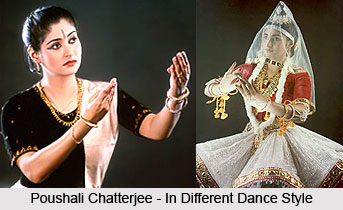At the tender age of 8 Poushali Chatterjee began her training in Manipuri Dance, under Shri Kunjo Singh. Daughter of renowned vocalist Smt Atashi Chatterjee, Poushali Chatterjee is indeed a name in the arena of Manipuri dance. After her early trainings from Smt Darshana Jhaveri and Smt Kalavati Devi, finally she came under the teaching of the legendary Guru Bipin Singh. At the age of 12 She has also received a National Scholarship.
 Poushali has choreographed a number of dance dramas, the chief among them being Krishnaleela, Rabindranath Tagores Kalmrigaya and Maharshi Bhagyachandra, a dance drama based on the life of the pioneer of Manipuri Dance. In 2003, she presented her first contemporary production Sama - The Harmony of Life, a fusion of Manipuri and Odissi that explores the rhythms of life.
Poushali has choreographed a number of dance dramas, the chief among them being Krishnaleela, Rabindranath Tagores Kalmrigaya and Maharshi Bhagyachandra, a dance drama based on the life of the pioneer of Manipuri Dance. In 2003, she presented her first contemporary production Sama - The Harmony of Life, a fusion of Manipuri and Odissi that explores the rhythms of life.
Poushali has also choreographed Agni - The Life Force, which delineates the many moods of fire, from the nurturing to the destructive. Recently she presented Icche - Shei to Bhangche, Shei to Gorche, a dance drama based on one of Rabindranath Tagores short stories.
In 1996, Poushali opened her own institution, Nandanik Manipuri Dance Academy, where she teaches her students the various styles of Manipuri Dance - Rasleela, Cholom, Thang-ta and Mridang playing - according to the scientific system of training devised by Guru Bipin Singh. At present, Poushali is a teacher and at the same time a researcher and a performer. She has recently finished a two-year a research project on the similarities and differences between Hindustani, Carnatic and Manipuri Tala and Music with a Fellowship from the Government of India.



















